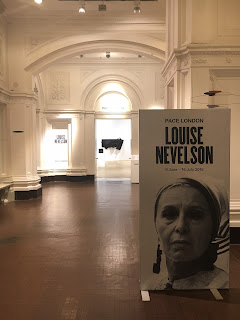Pace Gallery, 6 Burlington Gardens, London W1S 3ET
When an artist settles upon a muse, mode or material which
sustains their work for the rest of his or her career, such inspiration,
exploration (and sometime obsession) can either result in a formidable and extraordinary
oeuvre which transcends the “isms” of the timeframe within which the work was
produced, or become just a motif to constantly return to, re-hash and repeat in
an attempt to reclaim the intensity and originality contained in work
considered to represent the artist at his or her zenith. Thankfully, Louise Nevelson’s wooden assemblages
made from found objects (such as wine crates, parts of chairs and lengths of
wood jutting with nails) she gathered from the streets around her New York
studio from the 1950s, falls into the first scenario.
Untitled (late 1970s)
Nevelson’s most iconic installations are those which she painted
black, and it is a selection of these which are displayed at the Pace
Gallery. The artist painted her sculptures
to obliterate the past histories of the individual pieces which made up an assemblage
and unify the work. Black gave the work
a new shadowy, Gothic character. Nevelson
believed that the black paint gave her works an air of greatness and regal
enormity. By divorcing things from their
functions she lent them poetry. A piece
such as “Sky Cathedral – Moon Garden +
One” (1957-1960) was Nevelson's
sculptural answer to the Abstract Expressionist canvases of the predominantly
male artists that commanded the attention of American art during the
1950s. Nevelson was interested in the sublime and
spiritual transcendence. Sky Cathedral,
like many of her wall pieces, evokes the sense of a shrine or a place of devotion.
The artist wrote that in her art, she sought “the in-between places, the dawns
and dusk, the objective world, the heavenly spheres, the places between the
land and the sea.”((John Gordon, Louise
Nevelson (New York: Whitney Museum of American Art, 1967),12)
(Left) Sky Cathedral - Moon Garden + One (1957-1960)
(Right) Maquette for Dawn Shadows (1976-1983)
The sculptures in this exhibition range from small
assemblages to free-standing columns and monumental wall-based works. I found all of them so exquisite, so
carefully considered that to see them together as a group for the first time was
a delight and demonstrated how much visceral impact can be made when artist,
intent and material synergise. Scrutinising
the work up close was just as satisfying and I wished I had taken a sketchbook
with me, as I could have been occupied for hours reproducing small areas of
interest from the pieces.
Detail from Untitled (late 1970s)
Perhaps it was a curatorial intent to link Nevelson’s darkly
metaphysical and contemplative work to colour field painting as the darkly
painted gallery walls brought to mind the Rothko room at Tate Modern. The exhibition does offers a wonderful
respite to the usual Mayfair hubbub happening outside and if fact, is far more peaceful
than the Rothko room which is usually crammed with tourists taking selfies. I would highly recommend a visit to this quietly beautiful exhibition,
which runs until 16 July. Textbook
reproductions of Nevelson’s work simply cannot compete with experiencing her
work in such close proximity.
(Left) Cascades-Perpendiculars II (Night Music) (1980-82)
(Right) Untitled (1973)
Moon-Star Zag XII (1981)






No comments:
Post a Comment